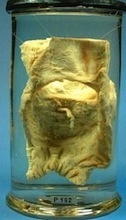Marc Abrahams's Blog, page 601
January 30, 2012
Eunuchs as better fighters?
Handicapping a genuine fight is not always as easy as it seems. As in other endeavors, much of the "everybody knows" knowledge ain't necessarily so. Consider this case study from the Scientific Research Centre of the Slovenian Academy of Sciences and Arts:
"Eunuchs as better fighters?" Simona Kralj-Fišer [pictured here] and Matjaž Kuntner, Naturwissenschaften, Volume 99, Number 2, 95-101, The authors report:
We recently showed that Nephilengys malabarensis eunuchs, i.e. sterile spider males that lost their genitals during copulation, become more aggressive during male–male contests. Here, we add crucial comparative data by exploring eunuch fighting behaviour in Nephilengys livida from Madagascar, specifically by testing the 'better fighter hypotheses' in a laboratory setting. Similar to N. malabarensis, N. livida copulations resulted in total male castration with the severed palp plugging the female genitals in 70.83% cases, which mostly (63.63%) prevented subsequent copulations. Unexpectedly, however, N. livida eunuchs exhibited lower aggressiveness than virgin males.
(Thanks to investigator Tom Gill for bringing this to our attention.)

January 29, 2012
For baggage belt, see monitors
Professional indexer Glenda Browne, who lives in Australia, has been traveling, observing all the while. She says:
We've been travelling in Europe. As an indexer, this sign took my fancy:

BACKGROUND: Browne was awarded the 2007 Ig Nobel Prize in literature for her study of the word "the" — and of the many ways it causes problems for anyone who tries to put things into alphabetical order. That study is:
"The Definite Article: Acknowledging 'The' in Index Entries," Glenda Browne, The Indexer, vol. 22, no. 3 April 2001, pp. 119-22.

Musicology: Cookin' lobsters
 For the avoidance of doubt (see our recent post 'Bumble Boogie') it should be noted that bees are by no means the only arthropods to feature in popular music themes. (Think : Crustaceans, Mites, Spiders, Vinegaroons &etc.)
For the avoidance of doubt (see our recent post 'Bumble Boogie') it should be noted that bees are by no means the only arthropods to feature in popular music themes. (Think : Crustaceans, Mites, Spiders, Vinegaroons &etc.)
A comprehensive list of musically-linked noninsect arthropods can be found in a recent paper by Professor Joseph R. Coelho (Biology Program, Quincy University, US) See: 'Noninsect Arthropods in Popular Music' (Insects, 2011, 2, pp. 253-263)
"The occurrence of noninsect arthropods in popular music was examined in order to explore human attitudes toward these species, especially as compared to insects. Crustaceans were the most commonly referenced taxonomic group in artist names, album titles and cover art, followed by spiders and scorpions."
Further explorations: Professor Coelho maintains his own website with a wealth of 'BugMusic' information on the presence of insects in Rock 'n' Roll music.

The bookish flight of Mr. Morris Lessmore
Today's short movie about Books and What's In Them is The Fantastic Flying Books of Mr. Morris Lessmore:
Some people seem to have noticed its appeal.
(Thanks to investigator Kevin Petrus for bringing this to our attention.)
BONUS: Suppose, now just suppose, that you had enough time to read all those books you're wanting to read. An episode of The Twilight Zone supposes that very thing (via @harpersnotes):

January 28, 2012
Association between personality profiles of decision makers and characteristics and performance of swine herds
 Today's Curiously Refreshing Title is:
Today's Curiously Refreshing Title is:
Association between personality profiles of decision makers and characteristics and performance of swine herds, Paul Yeske, University of Minnesota, 1999, 198 pages.
Award-winning author and vice-presidential candidate Paul Yeske is pictured here.
BONUS: Swinecast presents Paul Yeske, in video form:

January 27, 2012
Bumble Boogie
 For the first time, a peer-reviewed comprehensive discography of US-based apical musical recordings has been assembled. (Think : bees, hives, honey, buzzing, stingers, &etc). Professor William Lewis Schurk (Sound Recordings Archivist of the Music Library and Sound Recordings Archives at Bowling Green State University, Ohio, US) and colleague professor B. Lee Cooper, (presently at the North Carolina Center for Creative Retirement, US) have co-authored 'Bumble Boogie: 100 Years of Bee Imagery in American Sound Recordings—A Discography'. (Popular Music and Society, Volume 34, Issue 4, 2011)
For the first time, a peer-reviewed comprehensive discography of US-based apical musical recordings has been assembled. (Think : bees, hives, honey, buzzing, stingers, &etc). Professor William Lewis Schurk (Sound Recordings Archivist of the Music Library and Sound Recordings Archives at Bowling Green State University, Ohio, US) and colleague professor B. Lee Cooper, (presently at the North Carolina Center for Creative Retirement, US) have co-authored 'Bumble Boogie: 100 Years of Bee Imagery in American Sound Recordings—A Discography'. (Popular Music and Society, Volume 34, Issue 4, 2011)
"This discographic study explores several bee themes featured in more than 200 commercial recordings released in the United States during the past century. Themes cited include references to scent, terms of endearment, analogies to bee-related structures and hive-oriented treasures, allusions to romance, sexuality, and reproduction, and fears of physical pain and emotional rejection."
For some examples, see/hear these bee-centric musical excerpts via Youtube.
• Muddy Waters – I'm A King Bee
• Flight of the bumblebee
• Eric the half a bee
Note: The same team have also compiled : 'Odes to Obesity: Images of Overweight Men and Women in Commercial Sound Recordings: A Discography' (Popular Music and Society,Volume 34, Issue 2, 2011)
Coming soon: Cookin' lobsters.

'The night Dublin dissected an elephant'
Mary Mulvihill did a five-minute talk about 'The night Dublin dissected an elephant'. It (the night Dublin dissected an elephant — not Mulvihill's talk!) was was a big, smelly moment in the history of science. Here's video of her talk:
Allen Mullin did the dissection, way back when, in 1681. He described it in a book called An anatomical account of the elephant accidentally burnt in Dublin on Fryday, June 17 in the year 1681:


Still more about color preferences in the insane
Colltales adventures into the story of color preferences in the insane, jumping off from our excursion in that far-off land:
There are many reasons why the 1931 research "Color Preference in the Insane," by Dr. Siegfried Katz, was important. At the time, for example, lobotomy was still an accepted treatment for schizophrenia. In fact, the procedure involving cutting nerve fibers from the frontal lobe of the brain, where emotions are generated, would grant the 1949 Nobel Peace prize to Portuguese doctor Egus Moniz.
So kudos to the good doctor Dr. Katz, working at the New York State Psychiatric Hospital, for having chosen alternative ways to make mental patients "less agitated and aggressive"….
They found no "clear-cut relationship between color and psychiatric illness," and even questioned the use of color in diagnosis. And that was that. For all they cared, those patients who showed preference for some colors over others were, in all likelihood, well, insane.
As for us, color us lazy but never crazy for keeping going back to tap into the Improbable Research site's bottomless pit of humorous but dead serious scientific tales. Let us praise and thank those enlightened folks and their off-kilter take on things that never cease to tickle us.

January 26, 2012
Tipu's Tiger
 Maggie Koerth-Baker, Boing-Boing's ace science observer, is doing a series of essays about "My Favorite Museum Exhibit". The Bishop of Durham's rectum, on which we have spent an inordinate amount of time and space, because it has a curious back story, is there. (Well, actually, the Bishop's bottom, what's left of it, is in the Hunterian Museum, in London. The photo here, from the museum, shows the rectum at its best.)
Maggie Koerth-Baker, Boing-Boing's ace science observer, is doing a series of essays about "My Favorite Museum Exhibit". The Bishop of Durham's rectum, on which we have spent an inordinate amount of time and space, because it has a curious back story, is there. (Well, actually, the Bishop's bottom, what's left of it, is in the Hunterian Museum, in London. The photo here, from the museum, shows the rectum at its best.)
So, too, is the "Arab Courier Attacked by Lions", which resides at the Carnegie Museum of Natural History in Pittsburgh. That item reminds us of another of my favorites: Tippoo's Tiger, at the Victoria and Albert Museum in London.
 Tipu's Tiger is a mechanical toy built for Sultan Tipu (which you'll sometimes see spelled as Tipoo or Tippoo) of Mysore, India some time in the 1700s. It re-creates a roughly life-size tiger mauling a British military man, with accompanying horrendous noises. The mechanism is old and until recently had long been in disrepair. The museum recruited a highly skilled and appropriately cranky man to repair the mechanism (I once tried to interview him, thus learning about the crankiness).
Tipu's Tiger is a mechanical toy built for Sultan Tipu (which you'll sometimes see spelled as Tipoo or Tippoo) of Mysore, India some time in the 1700s. It re-creates a roughly life-size tiger mauling a British military man, with accompanying horrendous noises. The mechanism is old and until recently had long been in disrepair. The museum recruited a highly skilled and appropriately cranky man to repair the mechanism (I once tried to interview him, thus learning about the crankiness).
The museum web site has extensive descriptions of Tipu's Tiger. These videos, below show the toy, and go into some of the story of the restoration.
BONUS: The book Tipu's Tigers, by Susan Stronge of the V&A Museum
SPECIAL BONUS: The museum made a Tipu's Tiger app for the iPhone and iPod touch, which you can download free (and which plays "God Save the Queen" as the tiger mauls the soldier):

People Who Know Everything and then some
We receive, one way or another, many press releases, pitches, and other communications from People Who Can Explain Everything, or from publicists for People Who Can Explain Everything, or from people who have encountered press releases, pitches, and other communications from People Who Can Explain Everything. Here are two from the pile we encountered today:
1. A press release from Case Western Reserve University. It begins:
Radical Theory Explains the Origin, Evolution, and Nature of Life, Challenges Conventional Wisdom
CASE WESTERN RESERVE THEORIST DEVELOPS INCOMPARABLE MODEL THAT UNIFIES PHYSICS, CHEMISTRY, AND BIOLOGY
News Release: Thursday, January 26, 2012 — CLEVELAND – The earth is alive, asserts a revolutionary scientific theory of life emerging from Case Western Reserve University School of Medicine. The trans-disciplinary theory demonstrates that purportedly inanimate, non-living objects—for example, planets, water, proteins, and DNA—are animate, that is, alive. With its broad explanatory power, applicable to all areas of science and medicine, this novel paradigm aims to catalyze a veritable renaissance.
Erik Andrulis [pictured here], PhD, assistant professor of molecular biology and microbiology, advanced his controversial framework in his manuscript "Theory of the Origin, Evolution, and Nature of Life," published in the peer-reviewed journal, Life….
2. This trailer for a documentary film called The Master Palindromist. The producer says this is "A documentary film about a Master Palindromist honing his reversibility skills in an effort to reassess his life, and possibly change the world. Produced and Directed by Michael Rossi."
To these people People Who Can Explain Everything, and to all People Who Can Explain Everything, we say: Thank you, and good luck to you!
(Thank you to Ian Sample and Gus Rancatore, respectively, for bringing these particular People Who Can Explain Everything to our attention.)

Marc Abrahams's Blog
- Marc Abrahams's profile
- 14 followers


























